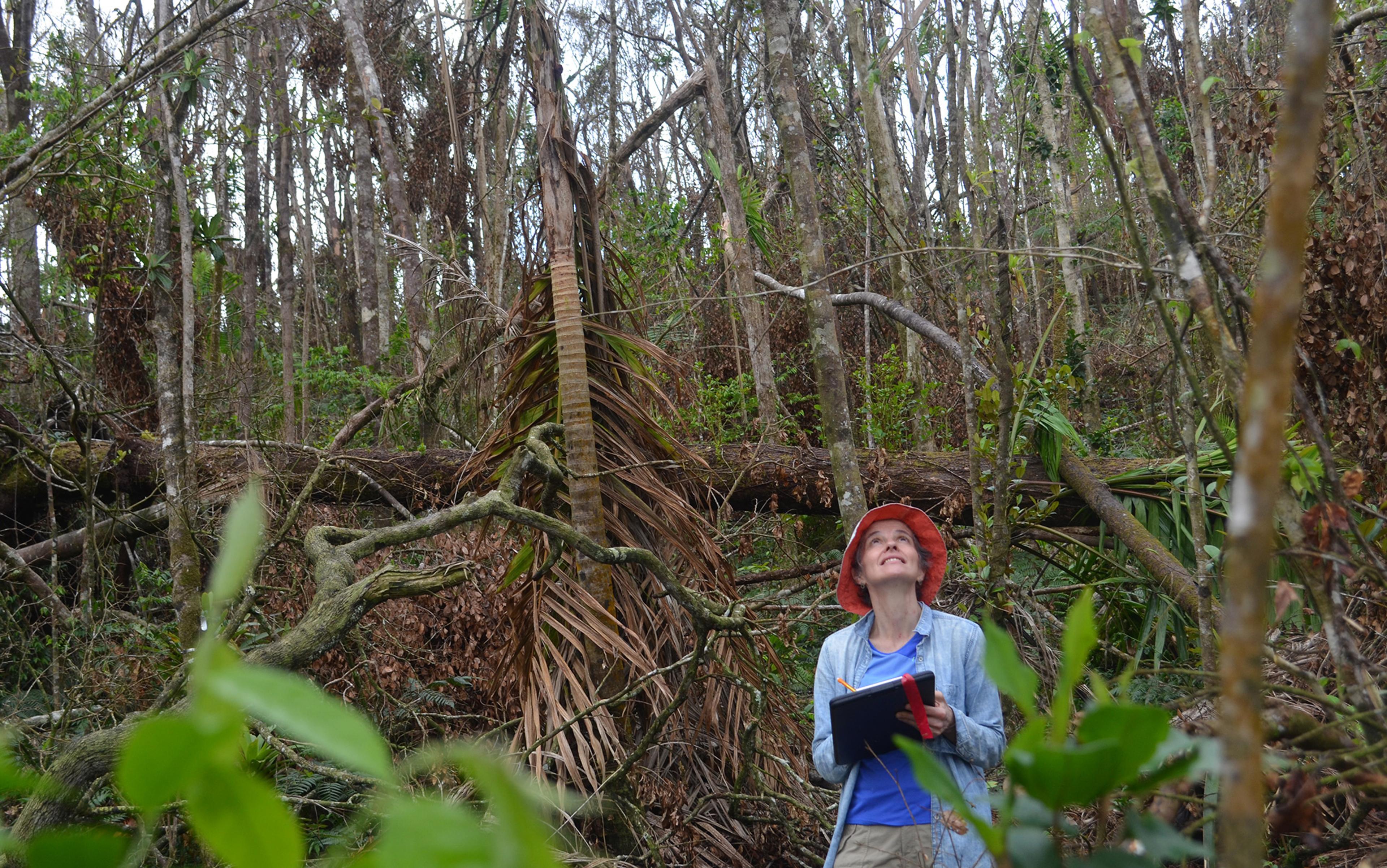When Hurricane Fiona flooded regions of Puerto Rico with up to 30 inches of rain in September last year, the island was still recovering from hurricanes Irma and Maria, two catastrophic storms in 2017 during which nearly 3,000 people died. Fiona left close to 200,000 residents without drinkable water and 1.3 million without power, highlighting the fragility of Puerto Rico’s infrastructure and the paucity of United States federal aid to its citizens.
Puerto Rico has experienced intense tropical storms for centuries, but anthropogenic climate change is altering their frequency, strength and character. For the past few decades, for example, the island has suffered both monstrous hurricanes and deep droughts: an unusual combination.
María Uriarte, a professor at Columbia University in New York, has studied this unusual combination at Luquillo for 20 years. Uriarte began her work on hurricanes in order to understand their destructive force, but without the anticipation that hurricanes themselves would change over the course of her career.
Uriarte is a disturbance ecologist, a biologist who studies how storms, fires, insect outbreaks and other events shape communities of plants and animals. Disturbance ecologists like her seek to understand how certain species persist in the face of stressors and even catastrophes. Some disturbances, like volcanic eruptions, are clearly caused by nonhuman agents. Others, like fires, invasive species and climate change, are a muddle of human and nonhuman forces. Anyone who has heard of pinecones that require fire to open or battled with the bindweed and dandelions that first colonise turned-over soil has encountered disturbance ecology.
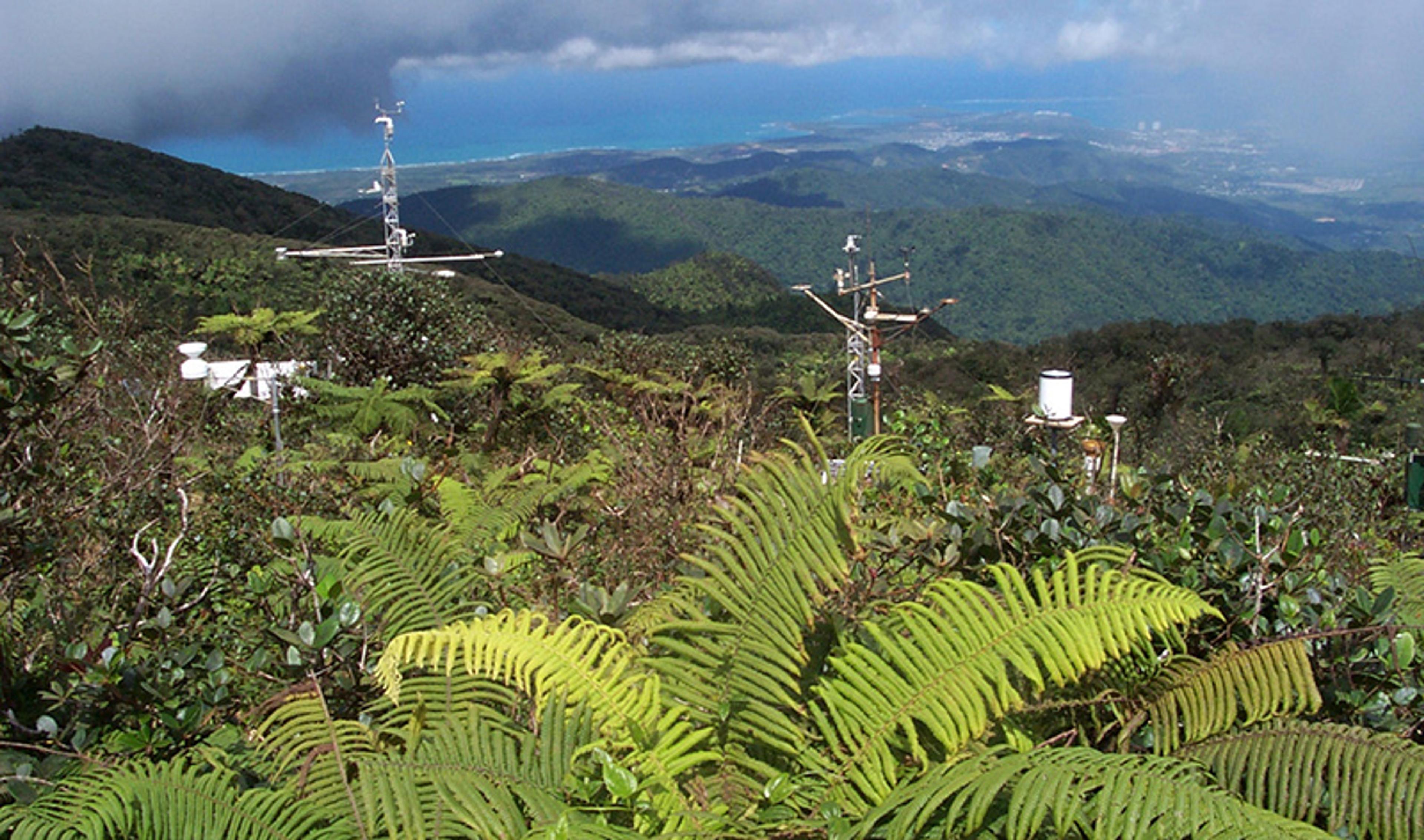
A meteorological station in the Elfin Forest of the Luquillo Mountains, Puerto Rico. Courtesy Luquillo LTER.
Since the 1960s, concepts from disturbance ecology have reshaped how scientists and other experts understand the biotic world. In particular, disturbance ecology brought new attention to the processes of stress and response, and to the qualities of fragility and resilience. Scientists are breeding drought-resistant plants. Land managers and landscape architects are striving to design ecosystems that will be resilient in the face of sea-level rise and extreme weather events. Cities around the world are developing climate resilience plans as governments try to anticipate the ecological future.
Disturbance ecology’s influence on global environmental management is what makes it so important to understand its strange Cold War history, one with roots in Puerto Rico, at some of the same sites where Uriarte works today.
For more than a century, scientists have gathered at the Luquillo Experimental Forest in the mountains of northeastern Puerto Rico to study ecological trauma: deforestation, erosion, hurricanes, chemical warfare, climate change – even nuclear holocaust. Luquillo is a place where scientists try to make sense of life’s resilience in a damaged world.
In 1965, when the ecologist Howard T Odum and his collaborators irradiated two hectares of Luquillo’s rainforests with 10,000 curies of caesium-137, the concept we now know as environmental resilience didn’t yet exist. ‘They managed to fry a hole in the forest,’ I’m told by Jess Zimmerman, current head of the Luquillo Long-Term Ecological Research programme. Over the following decade, the forest recovered, and the course of that recovery caught the attention of both ecologists and the US military.
The Luquillo rainforest irradiation project was one of hundreds of Cold War efforts in the US to imagine nuclear doomsday. Between 1945 and 1962, the US detonated approximately 300 nuclear weapons. These nuclear bombs transformed the physical and biological environments of the colonised Marshall Islands and the US southwest. The detonations led scientists and the public to recognise radioactive fallout as a regional and perhaps global threat to human health. Mounting concern over nuclear fallout came with the blunter fear of nuclear annihilation. In 1950, the US had 299 nuclear weapons in its stockpile. By 1960, it had 18,638. And by 1965, it had 31,139.
Ecologists damaged ecosystems, rather than warships or model towns, to understand if and how they recovered
As the US and the Soviet Union increased the size and range of their nuclear arsenals, it became possible – easy, really – to envision a catastrophic, global-scale war. Studies by the RAND Corporation, a think-tank with roots in the US Department of War, estimated that a first Soviet attack would be aimed at 50 US cities and would result in 90 million casualties. With such numbers in mind, the US Atomic Energy Commission (AEC) set out to predict the economic and social consequences of a third world war. They assembled model naval fleets. They built entire towns and populated them with mannequin residents in haunting scenes of white suburban life: the nuclear family, surrounded by new cars, furniture and appliances donated by manufacturers. Then they nuked them. The government distributed photographs and films of the aftermath in an attempt to convince the public that nuclear war was survivable, and that responsibility for disaster preparedness rested on the family. As the anthropologist Joseph Masco put it, through these simulations the government ‘sought to make mass death an intimate psychological experience while simultaneously claiming that thermonuclear war could be planned for alongside tornados, floods, and traffic accidents.’ The bombs used in these simulations were not imaginary, however, and doomsday came for those whose homes the government deemed sacrifice zones.
Between 1946 and 1958, the US detonated the equivalent of 7,000 Hiroshima bombs in the Marshall Islands. As of 2022, refugees from Bikini and Rongelap atolls are still unable to return home safely. In 1950, the federal government established the Nevada Proving Grounds on Western Shoshone and Southern Paiute lands, and subsequently conducted 100 atmospheric and 921 underground nuclear tests there. The tests released approximately 12 billion curies of radiation, causing decades of cancer and death. (For comparison, the Chernobyl disaster released an estimated 81 million curies of radiation.)
The US government tasked not just military planners, but also sociologists, and even science fiction writers, with doomsday research. Beginning in 1943, the Manhattan Project (and later, the AEC) hired ecologists to study what happened to plants and animals at detonation sites. Initially, scientists expected the vast ocean and atmosphere to quickly dilute radioactive fallout. Instead, they found that organisms accumulated radioactive elements in their bodies, and that organisms highest up the food chain were the most radioactive. Soon, researchers realised that a wide range of chemicals also ‘biomagnified’, including pollutants like heavy metals and the insecticide DDT.
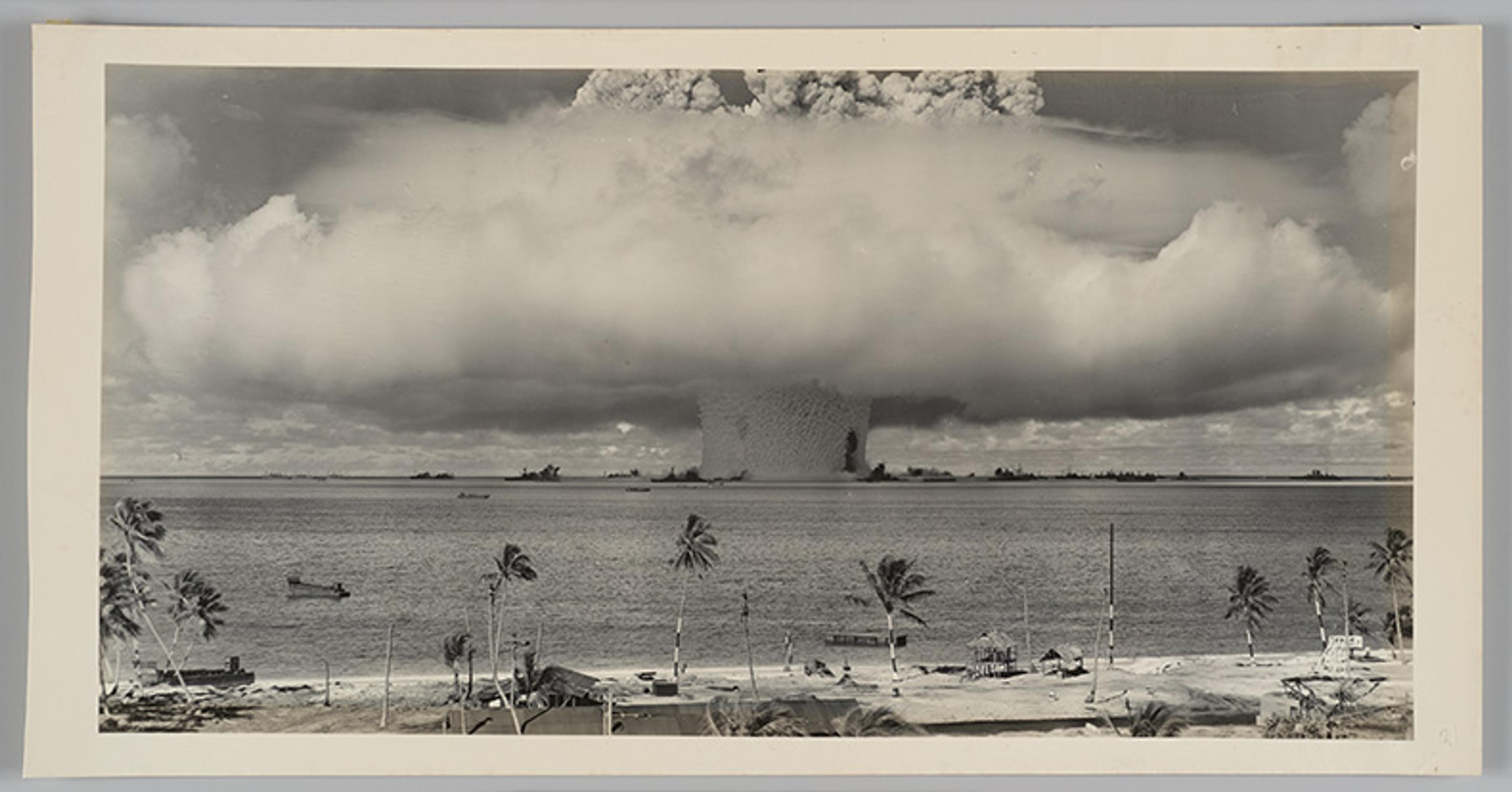
Test Baker as seen from Bikini Atoll, 25 July 1946. This underwater explosion sent a model fleet into the sky. Courtesy the Met Museum, New York.
Together with the idea of biomagnification, doomsday experiments birthed disturbance ecology, the study of how perturbations or stressors shape the components and character of an ecosystem. Government investment in the research began in 1961 when, in a classified report, the RAND Corporation urged the Pentagon to further investigate the ‘post-war recovery of devastated biotic environments’. Soon thereafter, the AEC began to fund studies in which ecologists purposefully damaged ecosystems, rather than warships or model towns, to understand whether they recovered and, if so, how. These were not fringe experiments: although it’s little remembered today, the AEC was the main funder of ecological research from the opening of the Second World War until the mid-1970s, when the National Science Foundation eclipsed it. Ecosystem science was doomsday science.
The first postwar ecological simulations happened at the Brookhaven National Laboratory on Long Island. In 1962, ecologists exposed a former agricultural field and an oak-pine forest to continuous gamma radiation from caesium-137 and cobalt-60 point-sources for five months. The AEC Office of Civil Defense supported this project. Its primary objective was to evaluate biotic recovery from radiation exposure at a scale that could result from nuclear war. Ecologists justified the experiment, which ran intermittently until 1978, by arguing that it was important to anticipate the effects of nuclear war in eastern deciduous forests near urban centres, because bombsites had been restricted to deserts and tropical atolls with limited floras.
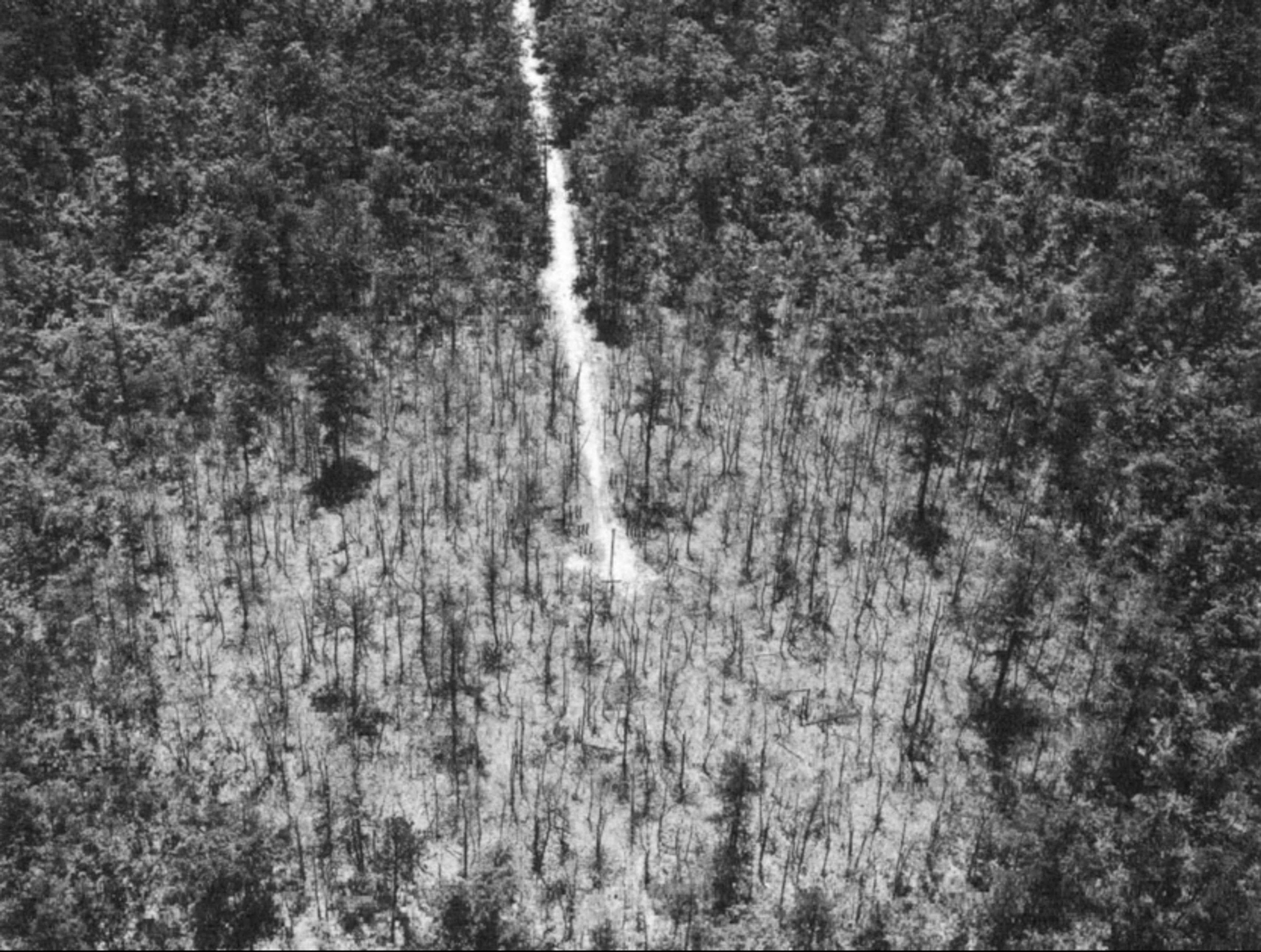
An aerial photograph of the Brookhaven National Laboratory Irradiated Forest Experiment after six months of exposure to gamma radiation. ‘Radiation and the Patterns of Nature’ by George M Woodwell, Brookhaven Lecture Series, 24 March 1965.
The radioactive deer that today roam Long Island are not the only legacy of this experiment. Through this atomic fieldwork, ecologists developed the idea of ‘comparative radiosensitivities’. Scientists at Brookhaven found that members of the daisy family survived high levels of radiation, whereas pine species were the most ‘sensitive’ to radiation. This was a new way of categorising species – not by taxonomy or by what-ate-what, but by their ability to withstand disturbance. Today many of us are familiar with thinking of species in this way: which species is most drought-tolerant, or able to withstand hurricanes, or likely to survive the climate crisis. But in a historical perspective this is a very new way of thinking about the qualities of a species.
After irradiating the rainforest, Odum’s team ‘watched with keen interest’ as the leaves began to yellow and fall
For more than a century, the US federal government has treated Puerto Rico as a laboratory for US social policy – and environmental policy. The AEC hoped the Luquillo irradiation experiment would help the mainland prepare for nuclear war. It also intended the irradiation of Luquillo to inform another imperial project, the proposed Project Plowshare Pan-Atomic Canal, a plan to ‘improve’ the Panama Canal (so that it would not require locks to move ships) by detonating a series of H-bombs through Panama. The US Department of Defense also tested Agent Orange and other ‘tactical herbicides’ for use in the Vietnam War at Luquillo. Puerto Rican forests were destroyed in an attempt to plan for the protection of mainland Americans.
For three months in 1965, Odum and his collaborators – eventually numbering in the hundreds – irradiated the Luquillo tropical forest site. They studied its recovery over the next six years. They compared the irradiated plot to two ‘control’ plots: one denuded of all vegetation, and one that received no treatment. After irradiating the rainforest for three months, Odum’s team ‘watched with keen interest’ as the leaves began to yellow and fall. After a few months, the moss turned an uncanny blue-black. Ultimately, most of the trees within 30 metres of the radiation source died. One of the most common plants in the Luquillo Experimental Forest, the sierra palm, was particularly sensitive to radiation, with a 94 per cent population decline. Other species proved resilient to radiation. A giant red-trunked Cyrilla tree exposed to a staggering 100,000 roentgen of radiation survived another 33 years before it died in a major rainstorm in 1998.
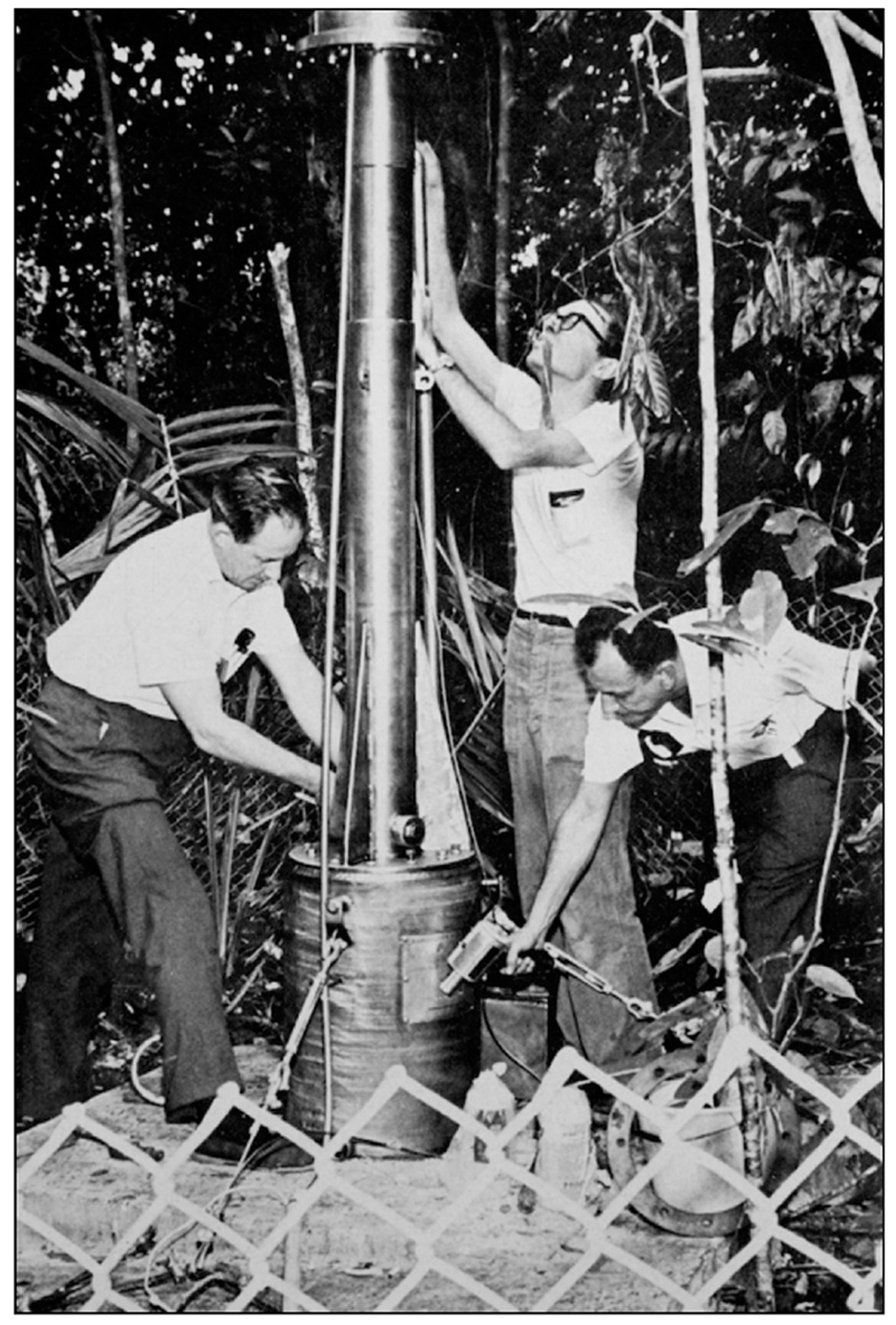
Scientists installing the base for the caesium radiation source in the Luquillo Experimental Forest. Image from the book A Tropical Rain Forest: A Study of Irradiation and Ecology at El Verde, Puerto Rico (1970), by Howard T Odum and R F Pigeon. Courtesy the National Technical Information Service, Springfield.
In Odum’s view, the forest ecosystem was an agent: faced with the stress of irradiation, it ‘actively resisted loss of its complexity’ by sprouting new seedlings on bare soil. He imagined early successional species as ‘wound healers in small damaged spots’. Two years later, the irradiated zone looked ‘like the scrubby growth in the Appalachian Mountains’. By 1969, bare rocks were re-covered with moss, and Cecropia trees were 30 feet high. To Odum and other ecologists, the irradiated forest’s ‘healing system’ and ‘repair mechanisms’ were similar to those of a human body.
By 1970, following the RAND Corporation’s recommendation that ‘studies of comparative radiosensitivity be enormously increased’, ecologists had placed radiation sources in a tropical rainforest at Luquillo and in agricultural fields and deciduous forests in New York, Nevada, South Carolina and Tennessee. Though conducted someplace in particular, ecologists’ Third World War simulations were always oriented towards developing generalised, transposable strategies for the survival of US citizens – except those living in Puerto Rico, the Marshall Islands, or Nevada. At the same time, ecologists believed that doomsday experiments would shed light on how the biotic world was naturally structured. In his book Ecological Effects of Nuclear War (1963), for instance, the ecologist George Woodwell explained that doomsday experiments were meant simultaneously to anticipate ‘the complex ecological problems involved in a nuclear holocaust’ and to define the ‘normal patterns of structure, function, and development characteristic of natural ecosystems’. Ecologists wanted to know how the world put itself back together again after disaster.
In pursuit of this knowledge, destruction became a standard method of studying ecosystems: ecologists also began clear-cutting, burning and applying biocides to their field sites. In a particularly dramatic example in 1966, Edward O Wilson, an entomologist at Harvard, and one of his graduate students, Daniel Simberloff, chose six islands in the Florida Bay on which to kill every living animal. First, they censused the insects on each island, then they tented entire islands and fumigated them with methyl bromide. After this ‘defaunation’, Simberloff re-censused the insect communities. To make sure the recolonising insects were arriving by ‘natural’ means, and not on Simberloff himself, he immersed himself in an insect repellent called Off! between visits. In the write-up of their experimental results, Simberloff and Wilson noted the precedent for their experiment in ecologists’ studies of field sites subjected to various ‘perturbations’, including insecticides and fire. Their project was partially funded by the Department of Defense. Ecology’s involvement with doomsday planning not only made this experiment possible – it made it conceivable in the first place.
Prior to the 1960s, most ecologists believed that, given time and space, nature would heal itself. They came to this conclusion through succession theory – the belief that ecological communities developed from unstable assemblages of species to a stable ‘climax community’ that adapted to its physical environment. Succession theorists held that human-caused ecological damage was reversible, with the important exception of species extinctions. Emblematic of this view is the book Man and Nature (1864) by George Perkins Marsh, a US scholar and diplomat. Marsh wrote that ‘natural arrangements, once disturbed by man’ would be ‘restored’ when man ‘retires from the field, and leaves free scope to spontaneous recuperative energies’. A similar view prevailed through the 1950s, bolstered by studies of farmland abandoned in New England, which seemed to revert quickly to dense forest. At the influential symposium ‘Man’s Role in Changing the Face of the Earth’ in 1955, the ecologist Edward Graham noted that nature easily recovered from intensive cropping, grazing, hunting and logging when people desisted from the damaging action. Ecological communities, he observed, had the ‘re-creative power’ to ‘reconstitute themselves when the cause of disturbance disappears’.
Ecosystem theory emerged when the US perceived itself to be under perpetual threat
Doomsday experiments, however, shook ecologists’ faith in a perpetually self-healing nature. Through experiments designed to damage ecosystems, it became conceivable that ecological recovery was not inevitable, and that ecosystems might cease to function entirely if sufficiently harmed by humans. As Woodwell wrote in 1965:
Most natural ecosystems of temperate zones retain their capacity for regenerating the climax after a wide range of types and degrees of damage. Forests are usually self-regenerating units, even after clear cutting; abandoned fields revert to stable native vegetations through a series of developmental stages … Destruction of the ecosystem, however, may reduce the potential of the site for supporting life for long periods, possibly for scores of years.
In doing so, disturbance ecology supplanted ecology’s earlier framework: succession theory. Ecological succession is the process of change in the composition of an ecological community over time. Succession theorists tended to see groups of plants and animals as developing increasing complexity over time until becoming an orderly and stable ‘climax community’.
It is no coincidence that ecological succession theory emerged alongside the idea of ‘manifest destiny’, the settler colonial belief that a succession from Native American to white ownership was natural and inevitable. Politics shape the questions that scientists ask and the metaphors they reach for. Ecosystem theory, in turn, emerged when the US perceived itself to be under perpetual threat. Ecologists began to ask how ecosystems maintained themselves when constantly barraged with stressors.
In the context of planning for doomsday, ecologists began to ask whether there was a threshold of damage at which ecosystems would lose their ability to restore themselves. A 1965 Department of Defense report noted that doomsday ecologists had discovered that ecosystems may be so damaged ‘that restoration can never be more than partial and incomplete’. Once the ‘ecological balance is seriously disturbed,’ the report continued, ‘[s]ome species, no longer controlled by their natural enemies, may multiply enormously; others, deprived of their normal sources of food or otherwise affected by the total change in the system, may disappear.’ Different species would thrive in a damaged world than those that came before. More than a decade later, an Office of Technology Assessment study for the US Senate Committee on Foreign Relations concluded that, after a Soviet attack, it would be difficult or impossible to restore an ecosystem to its pre-attack condition because of ‘the possibility of irreversible ecological changes’. What continued to haunt the discipline of ecology even after the end of the Cold War was not the blunt possibility of global annihilation, but the more subtle spectre of irreversible ecological change.
Doomsday ecology also entrenched the diversity-stability hypothesis, the basis of contemporary environmental management. This is the idea that an ecosystem containing more species will vary less in response to a disturbance than an ecosystem containing fewer species – whether that disturbance is a hurricane or a nuclear war. At an Ecological Society of America symposium on nuclear war in 1963, the ecologist Robert Platt argued that there was functional redundancy built into diverse ecosystems: in the case that certain species were removed by insects, drought, ionising radiation or other disturbances, diversity meant there would be ‘replacement species’. In justifying his Luquillo study, Odum explained that the experiments would reveal whether, in tropical ecosystems, high levels of species diversity provided ‘more mechanisms for survival and recovery’. Woodwell wrote that species diversity makes ecosystems ‘resilient in the face of disaster’, whether that disaster was ‘ionising radiation’ or ‘a gardener’s hoe’. By the 1980s, ecologists had come to see species diversity as a key measure of an ecosystem’s health.
Successive generations of ecologists have studied different versions of ecological doomsday, but the concepts and methods of disturbance ecology have remained the same. Luquillo has remained a centre of disturbance ecology, but today it is hurricanes and climate change that ecologists strive to simulate.
Beginning in November 2004, scientists created three types of hurricane simulation plots at Luquillo. In the first, they cut down and removed tree limbs to open up the canopy. In the second, they kept the tall trees intact but added downed limbs and detritus to the forest floor. For the third treatment, they both opened the canopy and added detritus. They compared these plots to control plots that they left untreated. They found that increased canopy openness was the dominant factor affecting forest regeneration. Increased sunlight and heat promoted seedling growth more than a lack of detritus. Research at Luquillo countered the prevailing view that tropical forests are fragile. Rather, they seemed well adapted to major disturbances, winds and floods, a hurricane regime that prevailed in the region for millions of years.
Thirteen years later, in September 2017, two very real and devastating hurricanes ripped through the hurricane simulation plots. Hurricane Irma, a category-5 storm, passed close to the main island of Puerto Rico on 7 September, leading to widespread power outages and water service disruptions. And on 20 September, Hurricane Maria directly hit the island. A category-4 hurricane with peak wind speeds of 155 miles per hour, it was the most intense hurricane to make landfall in Puerto Rico since 1928. In the weeks and months following, thousands of people died avoidable deaths. While researchers at George Washington University developed statistical models showing between 2,658 and 3,290 excess deaths for the period September 2017 to February 2018, the then-president Donald Trump called the response to Maria an ‘unsung success’. One of the worst natural disasters in US history, Hurricane Maria is now used as a case study for mainland disaster preparedness. A simulation of sorts.
Hurricane Maria immediately killed twice as many trees as previous storms
Uriarte’s work combines long-term observations – comparing the species described in Odum’s surveys with surveys after hurricanes Hugo (1989), Georges (1998) and Maria (2017) – and simulations that build enormous tents and trenches to exclude rainfall and simulate drought, or cutting down trees to simulate hurricane-force wind. Her lab’s major questions are: will more severe storms have fundamentally different impacts on forest recovery than less severe storms? And how do droughts and hurricanes interact?
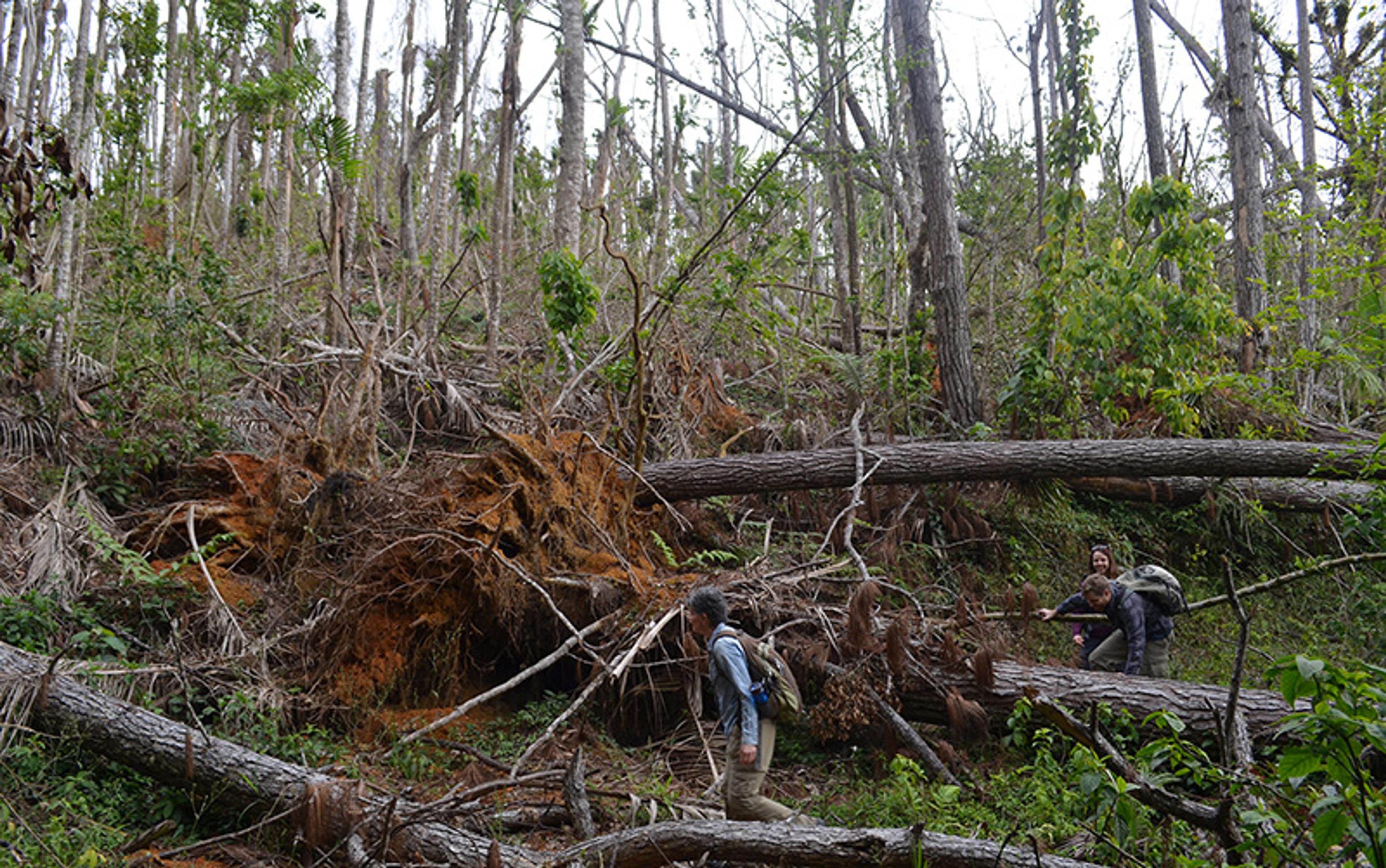
María Uriarte and students revisit a forest plot at Luquillo after Hurricane Maria. Courtesy Uriartelab, Columbia University.
Climate change models for the Caribbean predict longer dry periods, as well as hurricanes of greater strength and frequency. Uriarte and her colleagues found that Hurricane Maria immediately killed twice as many trees as previous storms, and broke more than three times as many trunks. Some species fared worse than others, with breakage rates up to 12 times those of previous hurricanes, including some of the slowest-growing, valuable hardwoods that were previously considered to be the most resilient to big storms.
Uriarte’s preliminary results, which will guide US Forest Service climate adaptation plans, suggest that species that survive hurricanes are vulnerable to drought. Puerto Rico’s forests might not be as disaster-resilient as scientists once believed. This means that scientists are far from being able to design tropical forests that are resilient to the climate crisis: climate models predict that annual precipitation amounts in Puerto Rico will decline by up to 1.3 metres, a dramatic change, even as the Caribbean experiences hurricanes of greater strength and frequency. When I ask Uriarte whether it will be possible to design and plant forests that are resilient to climate change, she hesitates. The tree species that are resistant to high winds are not always the same species that are resistant to drought. ‘If we had all the money in the world, all the knowledge, I think we’d still have to deal with these trade-offs,’ she says.
Today’s efforts at scenario planning, whether that scenario is climate change or a new COVID variant, share roots in doomsday planning of the 1960s. The goal is no longer prevention or containment, but mitigating inevitable harm. Resilience, the buzzword of our climate-changed present, is proven only through adversity. Judith Rodin, a former president of the Rockefeller Foundation, describes resilience as ‘the capacity of individuals, communities, institutions, businesses, and systems within a city to survive, adapt, and grow no matter what kinds of chronic stresses and acute shocks they experience.’
But touting resilience as a value or an asset can be toxic. As the Miami poet and Dominican immigrant Mario Alejandro Ariza writes in Disposable City (2020), the climate change resilience movement’s ‘suggestion of rugged self-reliance lies at the heart of North American neoliberalism and its correspondingly brutal moral order.’ When governments put the onus of resilience on communities, they ask communities to accept the status quo. Planting drought-resilient trees may prepare for climate change, but passing legislation to reduce fossil fuel use would strike at the root of the problem. To celebrate resilience is to imagine a future of perpetual harm.
This Essay is drawn from the book Wild by Design: The Rise of Ecological Restoration (2022) by Laura J Martin, published by Harvard University Press.
